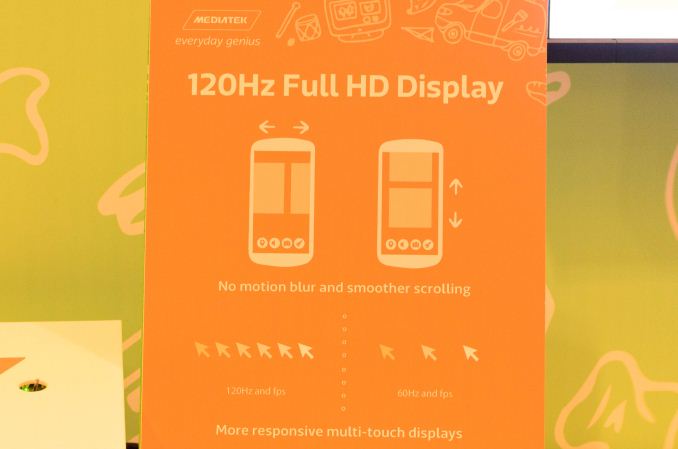MediaTek Demonstrates 120 Hz Mobile Display
by Joshua Ho & Brandon Chester on January 7, 2015 5:54 PM EST- Posted in
- Smartphones
- Mobile
- Tablets
- Trade Shows
- MediaTek
- CES 2015

While we often don’t deeply discuss MediaTek as a company, they are a major force in the mobile space. Their SoCs are widely used in the mid-range and budget segments of the mobile market, and they have widespread OEM adoption due to their turn-key reference designs. However, despite this mid-range positioning we saw an interesting demo of 120 Hz mobile displays at their CES press event, which can be seen below.
While the video is in slow motion to demonstrate the difference, in practice the benefit of the higher refresh rate is still quite visible. Text scrolling and motion was visibly clearer and more fluid, although it’s possible that displays with poor refresh rates wouldn’t see nearly as much benefit. MediaTek claims that this feature would increase display power consumption by about 10%, although it’s unclear whether this is with dynamic refresh rate adjustment or constant refresh rate. Features like this seem to be part of MediaTek’s new strategy of bringing value to the mid-range, and it will be interesting to see if MediaTek’s focus on Asia will continue to pay off.










31 Comments
View All Comments
Ortanon - Saturday, January 10, 2015 - link
I can't tell you how often I've tried to tell people this, about not only software but televisions too.jjj - Wednesday, January 7, 2015 - link
This is a feature their soon to arrive MT6795 supports - that chip being 8xA53 at 2.2GHz, dual chan memory and PowerVR G6200 @ 700 MHz , although official specs are hard to find. Anyway on the CPU side given the clocks and how their 1.7GHz A53 does it would perform pretty well,even more so with dual channel. The GPU, not so sure it can push 120FPS in actual games .... nobody tests actual games.blanarahul - Friday, January 16, 2015 - link
I think you meant MT6792.ddriver - Wednesday, January 7, 2015 - link
It will be a blast for people living in another temporal plane and experiencing the world in slow motion.ishould - Wednesday, January 7, 2015 - link
I'd love to see this come to future smartphones. This and 1ms response touch screens so we can really draw on the screen as if it were a physical object. Microsoft had a demo of this for their surface tableishould - Wednesday, January 7, 2015 - link
Here's a youtube video for an examplehttps://www.youtube.com/watch?v=vOvQCPLkPt4
ddriver - Wednesday, January 7, 2015 - link
1 ms is a complete overkill, 10 msec is enough to not impede a human in any way. Problem is touch interaction is a very low in the priority queue for device manufacturers, sure if you set yourself to it, you can make a device dedicated to that and have it nearly latency free, but in an actual user product, the device has to do a ton of other things, so you can't afford to waste precious CPU cycles on user interaction.Another problem is the way the vendors implement their device drivers, putting stuff like touch and sound last, or on the very top, and very far from the actual hardware in order to make room for other features which they deem more worthy of CPU power, and it is not a configuration you can switch, say you need fast touch for this app, fast audio for that app, it is all rather fixed, and takes years of time and development cycles to move something. But hey, that's what you get from people who put money making first and versatility and productivity last.
saratoga4 - Wednesday, January 7, 2015 - link
With most devices having many mostly idle cores, I doubt CPU load matters very much to latency. If it did, latency would continuously drop as more cores and higher clock speeds became the normal. Instead, its been barely improving even as huge increases in CPU power rolled out.The bigger issue is probably read out of the screen itself, the combined display+GPU latency, neither of which is very easy to improve or helped very much by faster SOCs. These are actually pretty hard to improve as capacitive sensing is very noisy, and GPUs are by design high latency devices.
ddriver - Wednesday, January 7, 2015 - link
As I said, it is the current implementations, both in software and the actual hardware, both are a "last priority" for hardware vendors. Typically, there is nothing preventing touch from having the same latency as a mouse, which is acceptably low, even though it includes the video output latency as well.Noise might be an issue only if filtering is handled in software, which would explain the terrible latency, and really it is something that needs to be handled in hardware, will not add more than a few cents to the BOM and can be plugged as a responsive generic user input device like a mouse or a keyboard. It doesn't happen because hardware vendors can still get away with their devices being as bad as they are when it comes to user interaction. It is entirely possible to fix this, but hardware vendors are lazy and greedy, and since it is something that will only benefit the consumer, nobody is in a rush to do it.
ABR - Thursday, January 8, 2015 - link
Is it the hardware or the software? Every time I try out an Android device in a store to this day the lags drive me crazy. But iOS and Windows Phone (despite supposedly always running on "worse" hardware) don't have this problem. My intuition is that the problem is Android is built on Linux, which is developed "server first", whereas both WP and iOS (despite also building on unix) are built UI first. (And on the other side, OS X performs lousily as a server.)